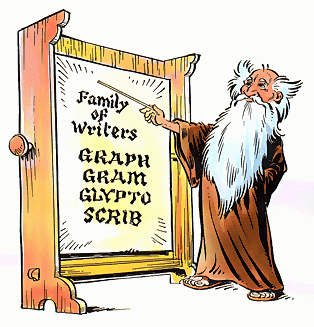Grapho- Words Meaning Write, Record: “dactyliography” to “etymography”,
Part 4 of 11.
Words that include: grapho-, graph-, -graph, -graphy,
-grapher, -graphia
(Greek: to scratch; write, record, draw, describe).

dactyliography, dactyliograph, dactyliographic:
The written description of finger rings.
dactylography, dactylograph, dactylographic:
The scientific examination of fingerprints (finger writing) for identification purposes.
defecography:
Radiographic examination of the act of defecation of a radiopaque stool.
demographer:
One who specializes in human statistical data.
demography, demograph, demographics:
1. That branch of anthropology that deals with the life-conditions of communities of people, as shown by statistics of births, deaths, diseases, buying habits, etc.
2. The study of populations, especially with reference to size, density, fertility, mortality, growth rate, age distribution, migration, and vital statistics.
dendrography, dendrograph:
An instrument used to measure the periodical variations in the size of tree trunks.
dermatography, dermatograph; dermography, dermograph:
A written description of the skin.
desmography:
A description of the ligaments of the body.
deuterography, deuterograph:
A duplicate written or printed pasage.
diagraphy, diagraph:
1. An instrument used for drawing mechanically projections of objects, enlarged copies of maps, etc.; it consists of a pencil governed by cords and pulleys, and guided by the application of a pointer to the object to be copied.
2. A combined protractor and scale used in plotting.
3. A combination of two letters to express a simple sound.
digraphy, digraph:
A group of two letters expressing a simple sound of speech.
dittography, dittograph, dittographic:
Double writing; the unintentional repetition of a letter or word, or series of letters or words, by a copyist.
doxography, doxograph:
A collection of philosophical opinions or teachings.
dromography, dromograph:
An instrument for measuring the velocity (rapidity) of the blood circulation.
dynamography, dynamograph:
An instrument for recording the amount of force exerted or (in medicine) the degree of muscular power.
dysantigraphia:
A form of agraphia in which the subject is unable to copy written or printed matter.
dysgraphia, dysgraphic:
The inability to write coherently (as a manifestation of brain damage).
ecclesiography, ecclesiograph:
A descriptive treatise about churches.
echocardiography:
The use of ultrasound in the investigation of the heart and great vessels and diagnosis of cardiovascular lesions.
echographia:
A form of agraphia in which one cannot write spontaneously, but can write from dictation or copy.
echography, echograph:
A device that automatically records echograms; ultrasonography.
eidography, eidograph:
An instrument for enlarging or reducing drawings.
electrobasography:
The graphic process by which an electrobasograph is made; used for gait analysis.
electrocardiograph:
An instrument for recording the potential of the electrical currents that traverse the heart and initiate its contraction.
electrocardiography:
1. A method of recording electrical currents traversing the heart muscle just prior to each heart beat.
2. The study and interpretation of electrocardiograms.
electrocardiophonography:
A method of electrically recording heart sounds.
electrocochleography:
A measurement of the electrical potentials generated in the inner ear as a result of sound stimulation.
electrography, electorgraph:
The process of copying an engraving on an electro-copper plate.
electromyography:
1. The recording of electrical activity generated in muscle for diagnostic purposes; both surface and needle recording electrodes can be used, although characteristically the latter is employed, so that the procedure is also called needle electrode examination.
2. Umbrella term for the entire electrodiagnostic study performed in the EMG laboratory, including not only the needle electrode examination, but also the nerve conduction studies.
epigraphy, epigraph, epigraphic:
1. The science concerned with the interpretation, classification, etc. of inscriptions. Often in narrower sense: the paleography of inscriptions.
2. A motto or quotation at the beginning of a book, chapter, etc.

Epigraphy is the study of ancient inscriptions or texts that have been written on hard, durable material, such as stone, marble, metal, clay, pottery, wood, and wax; using such techniques as engraving, carving, embossing, and painting.
Its aim is to determine the nature of the original records of ancient civilizations, thereby providing the primary data for historical and philological enquiry. In this process, it provides considerable insight into the early development of writing systems.
A variety of ancient inscriptions are found on or within large monuments, such as the Egyptian pyramids, or the Persian rock carving at Bisitun. Memorial inscriptions are also found on such objects as seals, rings, medals, and coins (a separate study called numismatics). Large numbers of clay and papyrus inscriptions have survived throughout the Near East containing information about historical events and daily business activities. There are also thousands of inscriptions of a more informal nature; such as, graffiti.
endocardiography:
Electrocardiography with the exploring electrode within the chambers of the heart.
epidemiography:
A descriptive treatise of epidemic diseases or of any particular epidemic.
epistolography, epistolograph, epistolographic:
Writing letters (messages).
ergodynamograph:
An instrument for recording both the degree of muscular force and the amount of the work accomplished by muscular contraction.
ergograph, ergographic:
An instrument for recording the amount of work done by muscular contractions, or the amplitude of contraction.
erotographomania:
A mania for writing ardent love letters, or an obsession with erotic writing.
esthesiography:
1. A description of the organs of sense and of the mechanism of sensation.
2. Mapping out on the skin the areas of tactile and other forms of sensibility.
esophagography:
Radiography of the esophagus using swallowed or injected radiopaque contrast media; the technique of obtaining an esophagogram.
ethnography, ethnographic:
The scientific description of nations or races of men, with their customs, habits, and points of difference.
ethography, ethographic:
The description of the morals and characteristics of mankind.
etymography, etymograph:
The historical accuracy of the origins and spellings of words.